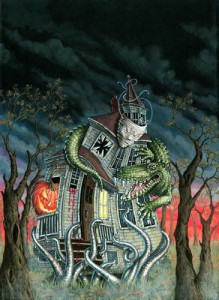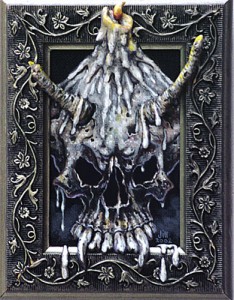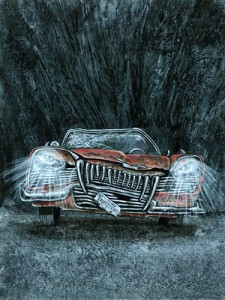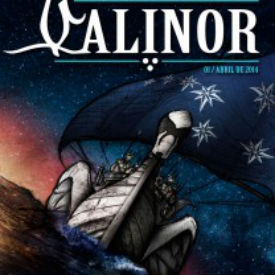
Why start this series with the spotlight on Jill Bauman? There’s a good reason, and it requires a little trip down memory lane:
When we first were drawn to collecting sf/f cover art in the late 1970s, it never occurred to us that we were pioneers, or that the artists we met at conventions or through letters we wrote to publishers, were part of a new generation—a bumper crop, actually—of incredibly talented artists. The whole field was exploding, soon to be a pop cult juggernaut. Previous generations of illustrators had no access to collectors, nor did they consider selling their originals a viable way to augment their income.
Until the 1970s, science fiction and fantasy artists’ fortunes largely rose and fell based on publishing industry “booms” and “busts”—and even well through the 1960s, few publishers were returning the art to artists, nor were artists complaining—so the idea of collecting it was even more distant from anyone’s mind. Then came the 1970s, and the fortunes of artists changed for the better. By the end of this important decade, the genre’s borders had greatly expanded (e.g., Star Wars, Dragon*Con, Ren Faires, D&D™) and artists were in demand, and fighting back. Verbal contracts were being replaced by written purchase orders; art was being returned after photography; and almost all artists were now signing their art, or figuring out clever ways to keep their signatures from being cropped out of the printed image. They also started demanding name credit for their art, on the copyright page, and by the end of the 1970s publishers were giving them that credit.

The artwork, and the artists’ names started to become recognizable to fans, as distinct from the books they appeared on or in . . . at about the same time as (and this was reinforced by) the artists showing their originals at science fiction and fantasy convention art shows. They first started displaying their originals to get jobs – naturally showing the best of what they could do so as to get the attention of art directors and publishers. We also began to go to cons in the mid-70s – so we met and grew friendly with those who were there. As well as, unwittingly, being exposed to the “best” those artists could do. Is it any wonder that we had to take some of that art home with us?
AS LUCK WOULD HAVE IT: Jill Bauman started her free-lance career in 1979. As luck would have it, when we started attending conventions, we started with those closest to where we lived . . . near New York City. As luck would have it, so did Jill—New York was also the “mecca” for book publishing, so that dozens of commercial artists lived in, or within commuting distance of, New York City. As luck would have it, Jill Bauman was a very savvy artist. She was one of the first to recognize the value of showing her work at conventions. Therefore, and as luck would have it . . . who would be among the first artists we ever met, and got to be friendly with, and wanted to own the art of? JILL.

Outgoing, up-beat, gregarious, and with a sharp, New Yorker’s sense of humor and directness. . . Jill was a real stand-out. As was her art. She didn’t mind talking to us about it, she introduced us to other artists. She invited us to her house and studio. It was an amazing thing for us . . . something we had never done before. What we weren’t prepared for, was her outright refusal to sell us what she had on display. We thought it was strange (and even eccentrically amusing) until we learned, to our dismay, just how widespread this reluctance to sell, was—especially among the most successful of illustrators. It took us YEARS of begging and pleading to acquire “interplanetary Zoo.” Her “Dark Assortment” we never could pry loose. 🙁

We couldn’t figure this out, at first….although that “NFS” (not for sale) sensibility was still running strong among artists until the 90s. In part, we learned, the reluctance to sell was because they “didn’t have to” – as commercial artists (and to paraphrase the Queen), they could afford to have their art, and eat it, too. But another reason for unwillingness to sell, was simply not knowing what to ask for it. At a time when no market for illustration art existed, what would be the right price to put on it???
Jill began her freelance career after teaching art in public schools and raising a family. It took a divorce to force her to shift gears, first running a successful antique business for ten years while raising two daughters. Then came the 70s, and it seemed the right time for her to “follow her dream” and return to painting. As she puts it now, 35 years later, “Living my dream, I’ve had an amazing adventure that included learning, self-discovery and meeting wonderful, talented people”. Not to mention, In that span of time, also producing hundreds of covers in the horror, mystery, fantasy, and science fiction genre.

Especially adept at making horror seem like fun, Jill has illustrated books for authors such as Stephen King, Harlan Ellison, Peter Straub, Lilian Jackson Braun, David Brin, and Fritz Leiber. She has been nominated for the World Fantasy Award five times and for the Chesley Award several times. Her art has been exhibited at the Delaware Art Museum, Moore College of Art, Science Fiction Museum, NY Art Students League and the NY Illustrators Society. See and learn much more at www.jillbauman.com

“Book illustration is where I combine both love for reading and art,” she says, “and the world of illustration and the publishing market has evolved with time. Adapting to the changes in the market has been a process that I’ve embraced, including the “digital”. Still, I prefer to paint with brushes on canvas, pencil on paper and feeling clay in my hands.” As a result, Jill works mainly for small press publishers these days, like Cemetary Dance Publications. These have become a major source of jobs for many of the ‘pre-digital’ generation of artists who rely on “indie” publishers to appreciate the power of painted book and magazine illustrations.
Jill creates personal works for her own enjoyment, sells her work to private collectors, and also takes private commissions. She has a thriving sideline in producing signed, limited editions of her personal works, selling them in numerous venues, including eBay under the name “jillyzart”
A project Jill has been working on for many years, that she calls “Nightthings,” involves small pieces pieces of art that she paints and sets im ornate frames, then uses air-dry clay to make 3D parts of the painting spill out onto the frame.

Her “Candleholder” (shown right) is an example and she looks forward to a gallery showing of these works in the future.
Dark poetry, flash fiction and short stories are also creative pursuits for Jill, and she has publishjed her poetry and fiction over the years in such periodicals as Weird Tales, Flesh & Blood and The Horror Express. She likes to include border designs as illustrations for her poetry. Her goal is to have published an illustrated collection of her dark poetry titled “Inkblots.”
Jill still attends a few conventions each year, and Necon—a small convention held in Rhode Island – is her favorite.

She has been going to that con for 33 years, and as she puts it “the people have beome family.” She also attends the World Horror Convention from time to time, most recently in 2013 (held that year in New Orleans). In 2014 she will be displaying her art and attending both the Long Island Comicon called “Eternal Con” in June, and Necon in July.
One more thing: In 1978, as a result of meeting Walter Velez, who was already an established illustrator—but one who would rather stay home and paint than have to talk an art director into giving him a job – in return for helping her develop her art for a commercial market, she agreed to be his agent. The relationship continues, and has proven to be a long and successful one for both artists. In time, Jill ended up representing other artists, among them Richard Bober. Both Velez and Bober make excellent candidates for this series, and my spotlight will be shining on each of them, very soon!











1 Comment